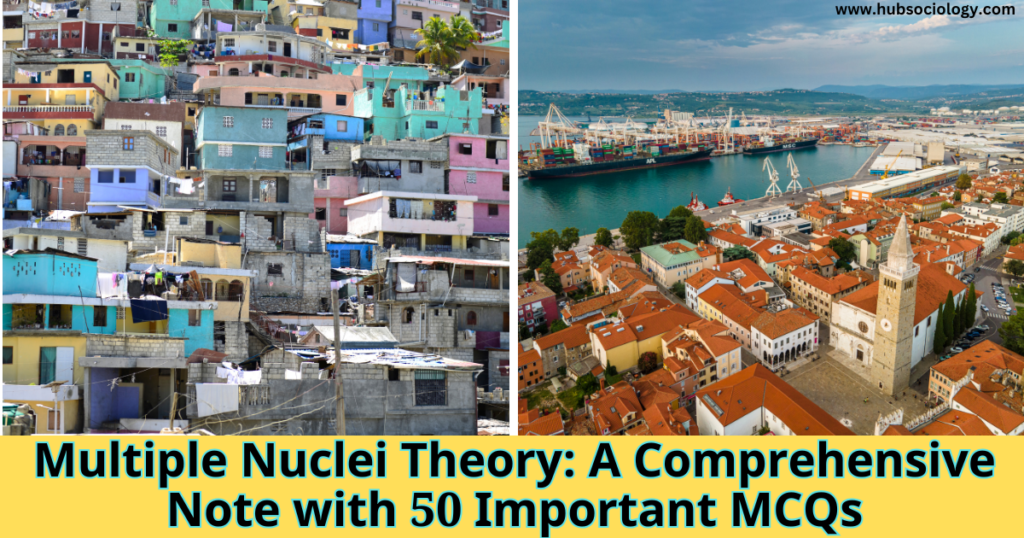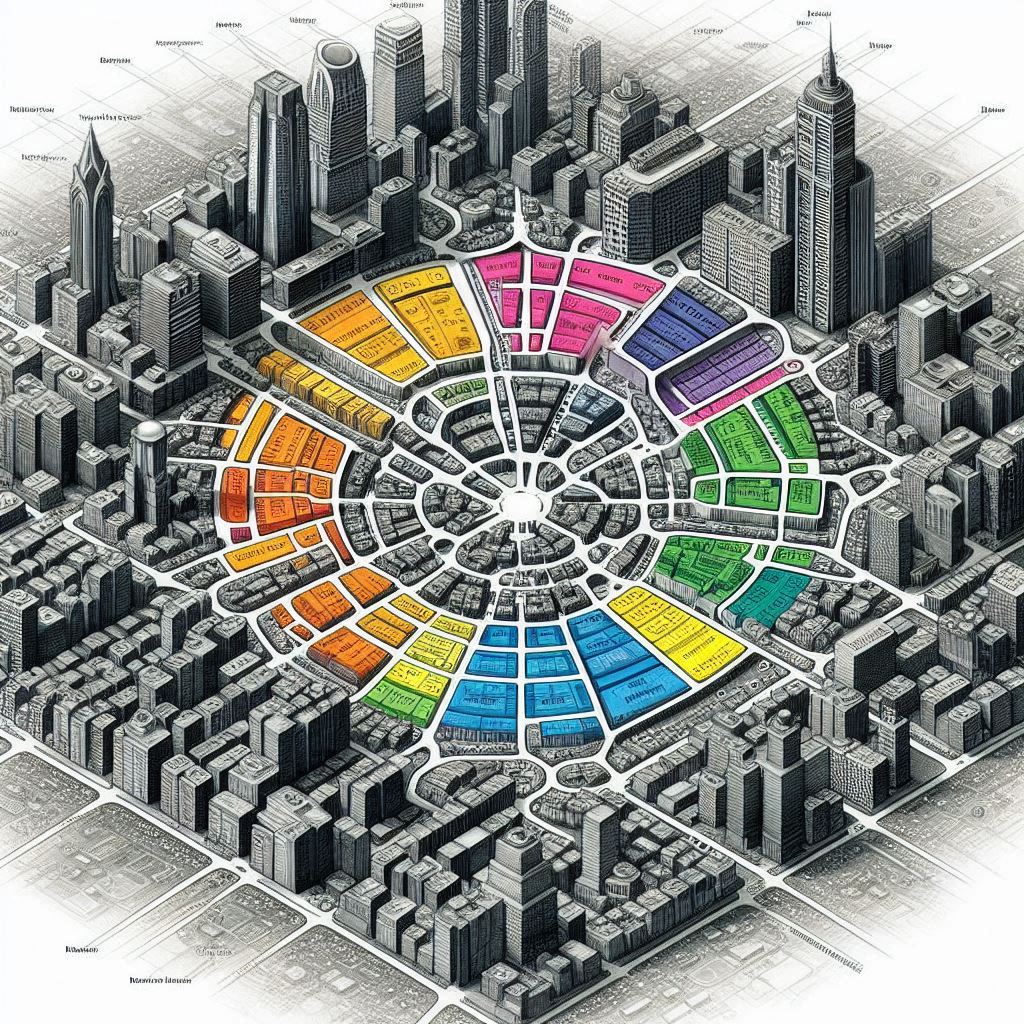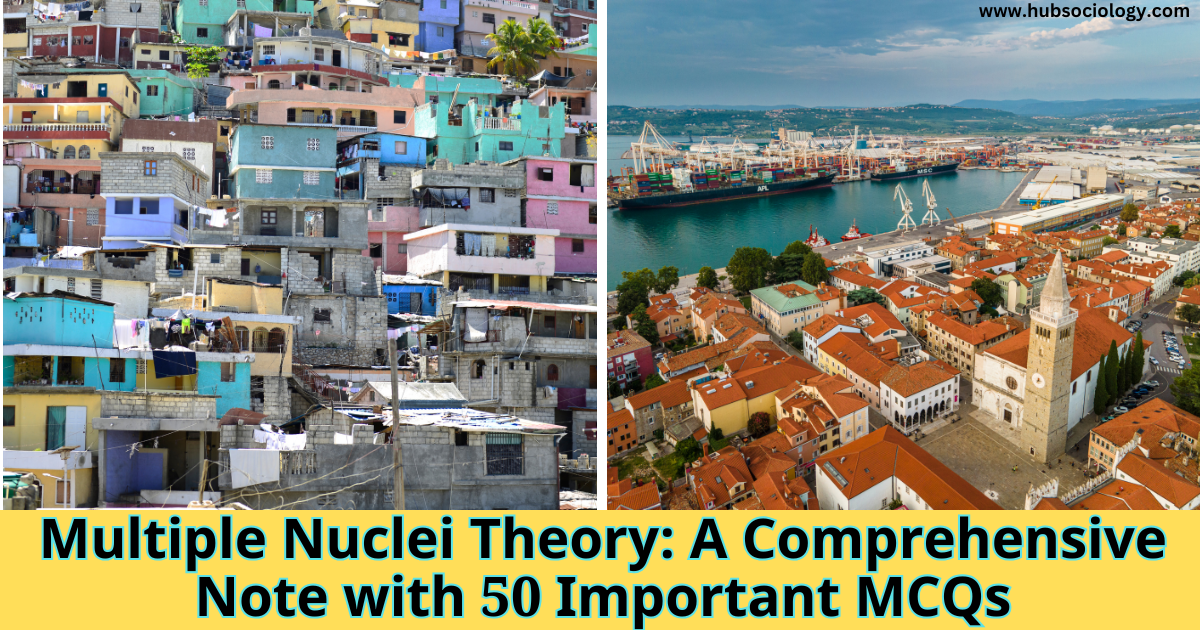
Urban sociology is a rich field that explores the evolution, structure, and dynamics of urban environments. One significant contribution to this field is the Multiple Nuclei Theory, a model introduced by Chauncy Harris and Edward Ullman in 1945. The theory redefined urban development and spatial organization by moving away from traditional monocentric models, such as the Concentric Zone Model and Sector Model, to a polycentric perspective. According to Harris and Ullman, cities evolve around multiple centers or nuclei, each serving distinct economic, social, or cultural functions, thus reflecting the complexity and diversity of modern urban life.
The Origins of the Multiple Nuclei Theory
The Multiple Nuclei Theory emerged during a period of rapid urbanization and industrialization in the United States. Traditional urban models, such as the Concentric Zone Model by Ernest Burgess and the Sector Model by Homer Hoyt, were predominant at the time. While these models provided valuable insights, Harris and Ullman observed that they failed to account for the diverse and multifaceted nature of urban growth.
Harris and Ullman’s theory argued that cities do not develop around a single core or central business district (CBD). Instead, they grow around multiple centers or nuclei, each serving specific functions and attracting distinct activities. These nuclei could include industrial zones, residential areas, shopping districts, or cultural hubs, among others.
Core Principles of the Multiple Nuclei Theory
The Multiple Nuclei Theory is built on several key principles that distinguish it from earlier urban models:
- Polycentric Development: Cities develop multiple centers of activity, each catering to specific needs and functions. These centers emerge organically or through deliberate planning.
- Specialization of Land Use: Different nuclei attract specific types of land use based on their functionality. For instance, an industrial nucleus may attract factories and warehouses, while a residential nucleus may develop schools and parks.
- Economic and Social Forces: The location of nuclei is influenced by economic factors (e.g., land costs, accessibility) and social dynamics (e.g., class segregation, ethnic enclaves).
- Competition and Compatibility: Certain land uses are compatible and cluster together, while others are incompatible and remain separated. For example, heavy industrial zones are often located away from high-income residential areas due to pollution and noise.
- Dynamic Growth: Urban areas are not static; they evolve as new nuclei emerge and existing ones expand or contract. This dynamic nature reflects the changing needs and priorities of urban populations.
Components of the Multiple Nuclei Model
The theory identifies several types of nuclei that form the basis of urban development:
- Central Business District (CBD): While not the sole nucleus, the CBD remains a significant center for commerce, administration, and cultural activities.
- Wholesale and Light Manufacturing Zones: These areas are often located near transportation hubs and serve as centers for goods production and distribution.
- Low-Class Residential Areas: Typically situated near industrial zones, these areas provide affordable housing for workers.
- Middle- and High-Class Residential Areas: These zones are located farther from industrial activities, offering better living conditions and amenities.
- Suburban Centers: These nuclei cater to the needs of suburban populations, including shopping malls, schools, and recreational facilities.
- Industrial Suburbs: Specialized zones for heavy industries, often located on the outskirts of the city to minimize environmental impact.
- Cultural and Educational Centers: Areas dedicated to universities, museums, theaters, and other cultural institutions.
- Transportation Nodes: Hubs for railways, airports, and highways that facilitate connectivity within and beyond the city.
Sociological Implications of the Multiple Nuclei Theory
The Multiple Nuclei Theory offers profound insights into the social fabric of urban environments. It highlights how spatial organization influences and reflects social structures, interactions, and inequalities.

1. Segregation and Social Stratification
One of the critical sociological aspects of the theory is its emphasis on segregation. Different nuclei cater to distinct socio-economic groups, leading to spatial segregation based on income, ethnicity, and occupation. For example, low-income populations often reside near industrial zones due to affordability, while affluent groups settle in suburban or high-class residential areas.
2. Community Formation
The theory underscores the role of nuclei in fostering community identities. Ethnic enclaves, cultural hubs, and educational centers serve as focal points for social interactions and collective identity formation. These nuclei become spaces where shared values, traditions, and practices are nurtured.
3. Urban Inequality
The polycentric nature of cities, as described by the Multiple Nuclei Theory, often exacerbates urban inequality. Access to resources, services, and opportunities varies significantly across different nuclei. For instance, residents of suburban centers may enjoy better schools and healthcare facilities compared to those living near industrial zones.
4. Cultural Diversity
The emergence of multiple nuclei also fosters cultural diversity within cities. Different centers cater to specific cultural, recreational, and educational needs, creating a mosaic of cultural expressions. This diversity enriches urban life but also poses challenges related to integration and cohesion.
5. Urban Mobility and Accessibility
The theory highlights the importance of transportation and accessibility in shaping urban life. The location and functionality of nuclei are heavily influenced by connectivity. Efficient transportation systems enhance mobility and facilitate interactions between different nuclei, while inadequate infrastructure can lead to isolation and marginalization.

Criticisms and Limitations of the Multiple Nuclei Theory
While the Multiple Nuclei Theory has been influential, it is not without criticisms and limitations:
- Oversimplification: Critics argue that the model oversimplifies the complexity of urban growth. Real-world cities often exhibit overlapping and hybrid land uses that do not fit neatly into distinct nuclei.
- Static Representation: The theory provides a snapshot of urban structure but does not adequately capture the dynamic and fluid nature of urban change over time.
- Economic Focus: The emphasis on economic and functional factors overlooks other critical influences, such as political decisions, environmental concerns, and cultural dynamics.
- Western-Centric Perspective: The theory is based on observations of American cities and may not fully apply to cities in other cultural or historical contexts.
- Neglect of Informal Settlements: The model does not account for informal settlements and slums, which are significant components of urban landscapes in developing countries.
Relevance in Contemporary Urban Studies
Despite its limitations, the Multiple Nuclei Theory remains relevant in contemporary urban studies. Its principles have been adapted and expanded to address the challenges of modern urbanization.
1. Urban Sprawl and Suburbanization
The theory provides a framework for understanding urban sprawl and the growth of suburban areas. As cities expand, new nuclei emerge to cater to the needs of suburban populations, reflecting the ongoing decentralization of urban life.
2. Globalization and Megacities
In the era of globalization, the Multiple Nuclei Theory helps explain the emergence of megacities with multiple international business districts, cultural hubs, and specialized zones. Cities like Tokyo, New York, and Mumbai exemplify this polycentric growth.
3. Sustainable Urban Planning
Urban planners use the principles of the theory to promote sustainable development. By creating self-sufficient nuclei with mixed land uses, planners aim to reduce commuting distances, traffic congestion, and environmental impact.
4. Technological Advancements
The rise of telecommunication and digital infrastructure has reshaped urban dynamics, leading to the emergence of new types of nuclei, such as tech parks, innovation hubs, and e-commerce centers. The theory provides a lens to analyze these developments.
Conclusion
The Multiple Nuclei Theory represents a significant shift in urban sociology, challenging traditional monocentric models and emphasizing the complexity of urban growth. It highlights how cities evolve as dynamic entities with multiple centers of activity, shaped by economic, social, and cultural forces.
From its origins in the mid-20th century to its application in contemporary urban planning, the theory has offered valuable insights into the spatial organization and social fabric of cities. While it has its limitations, its core principles continue to inspire sociologists, geographers, and planners to explore the multifaceted nature of urban life.
As urbanization accelerates and cities become increasingly complex, the Multiple Nuclei Theory will remain a vital tool for understanding and addressing the challenges of urban development in the 21st century.
Multiple Choice Questions
Basic Concepts of the Multiple Nuclei Theory
- Who introduced the Multiple Nuclei Theory?
A) Ernest Burgess
B) Homer Hoyt
C) Chauncy Harris and Edward Ullman
D) Max Weber
Answer: C - In what year was the Multiple Nuclei Theory introduced?
A) 1935
B) 1945
C) 1955
D) 1965
Answer: B - The Multiple Nuclei Theory suggests cities develop around:
A) One central nucleus
B) Multiple specialized centers
C) Concentric zones
D) Uniform residential areas
Answer: B - The term “nucleus” in the theory refers to:
A) A political boundary
B) A functional center
C) A natural feature
D) A cultural artifact
Answer: B - The theory was proposed to address limitations in which previous urban model?
A) Concentric Zone Model
B) Sector Model
C) Central Place Theory
D) Both A and B
Answer: D - Which of the following is a key principle of the Multiple Nuclei Theory?
A) All cities have identical growth patterns
B) Urban development occurs around multiple centers
C) Cities only expand outward from the CBD
D) Industrial zones are always central
Answer: B - According to the theory, industrial zones are typically located:
A) Adjacent to high-income residential areas
B) Near transportation hubs
C) In the city center
D) Far from any residential zones
Answer: B - A suburban center is an example of:
A) Central nucleus
B) Peripheral nucleus
C) Incompatible land use
D) Transitional zone
Answer: B - Which of the following zones is not typically part of the Multiple Nuclei Model?
A) Low-class residential areas
B) CBD
C) Slums and informal settlements
D) Transportation nodes
Answer: C - What is one reason for the emergence of multiple nuclei in cities?
A) High population density in rural areas
B) Economic specialization and competition
C) Uniform land costs across all zones
D) Lack of transportation infrastructure
Answer: B
Sociological Implications
- The theory highlights spatial segregation based on:
A) Religion
B) Class, income, and ethnicity
C) Agricultural activity
D) Political boundaries
Answer: B - Cultural hubs in cities serve as centers for:
A) Industrial activities
B) Residential segregation
C) Shared values and identity formation
D) Suburban sprawl
Answer: C - What sociological issue does the theory help to explain?
A) Urban inequality
B) Tribal communities
C) Rural depopulation
D) Global warming
Answer: A - The presence of ethnic enclaves in cities reflects:
A) Economic segregation
B) Cultural cohesion and community identity
C) A lack of social stratification
D) Absence of nuclei
Answer: B - Urban mobility depends heavily on:
A) Economic policies
B) Political stability
C) Transportation infrastructure
D) Population size
Answer: C - Which factor is least likely to influence the formation of a nucleus?
A) Land costs
B) Transportation access
C) Seasonal weather
D) Economic activity
Answer: C - Residential nuclei are often segregated based on:
A) Industrial activity
B) Population size
C) Socio-economic class
D) Cultural infrastructure
Answer: C - Which term best describes the diversity of urban centers in the Multiple Nuclei Theory?
A) Homogeneity
B) Polycentricity
C) Monocentricity
D) Redundancy
Answer: B - The theory implies that urban inequality can result from:
A) Unequal distribution of resources across nuclei
B) Overcrowding in rural areas
C) The absence of CBDs
D) A lack of transportation facilities in suburbs
Answer: A - One benefit of multiple nuclei is that they foster:
A) Greater traffic congestion
B) Economic diversity
C) Urban stagnation
D) Uniform urban growth
Answer: B
Applications and Criticisms
- What does the theory suggest about the growth of modern cities?
A) Growth is static
B) Growth is dynamic and decentralized
C) Growth follows concentric patterns
D) Growth ignores land costs
Answer: B - Which urban feature is overlooked by the theory?
A) Cultural zones
B) Informal settlements
C) Residential areas
D) Transportation hubs
Answer: B - A major criticism of the theory is its:
A) Oversimplification of urban dynamics
B) Overemphasis on political factors
C) Ignorance of industrial activity
D) Static representation of land use
Answer: A - The theory is most applicable to cities in:
A) Developing countries
B) Western, industrialized nations
C) Rural areas
D) Tribal communities
Answer: B - Which of the following is not considered a nucleus?
A) University zone
B) Slum area
C) Transportation node
D) Suburban shopping mall
Answer: B - The Multiple Nuclei Theory is used in urban planning to:
A) Promote monocentric development
B) Analyze diverse land uses
C) Eliminate suburban sprawl
D) Minimize cultural diversity
Answer: B - A limitation of the theory is its:
A) Failure to address land use competition
B) Western-centric perspective
C) Focus on informal economies
D) Lack of applicability to industrial cities
Answer: B - What is a practical use of the theory in modern cities?
A) Designing self-sufficient centers
B) Eliminating cultural diversity
C) Promoting monocentric CBD growth
D) Ignoring suburban expansion
Answer: A - The theory provides insights into the growth of:
A) Megacities and global hubs
B) Rural villages
C) Isolated industrial towns
D) Underdeveloped tribal regions
Answer: A - The emphasis on multiple centers helps planners address:
A) Economic disparities
B) Political governance
C) Rural-urban migration
D) Population decline
Answer: A
Comparative Urban Models
- Which model contrasts most sharply with the Multiple Nuclei Theory?
A) Concentric Zone Model
B) Central Place Theory
C) Sector Model
D) All of the above
Answer: D - The Sector Model emphasizes:
A) Concentric rings
B) Linear expansion along transportation corridors
C) Multiple centers of activity
D) Random urban growth
Answer: B - The Concentric Zone Model was developed by:
A) Chauncy Harris
B) Homer Hoyt
C) Ernest Burgess
D) Edward Ullman
Answer: C - What does the Central Place Theory focus on?
A) Rural population dynamics
B) Distribution of goods and services
C) Social segregation
D) Residential zoning
Answer: B - Which model introduces the concept of high-income residential corridors?
A) Sector Model
B) Multiple Nuclei Theory
C) Concentric Zone Model
D) Bid-Rent Theory
Answer: A
Advanced Analysis
- Polycentric cities are characterized by:
A) A single dominant nucleus
B) Decentralized urban functions
C) Uniform development patterns
D) Segregated rural zones
Answer: B - The rise of tech hubs exemplifies:
A) Static urban centers
B) New forms of nuclei
C) Declining urban specialization
D) The elimination of cultural zones
Answer: B - A “nucleus” in the theory can emerge due to:
A) Political decisions
B) Economic demand
C) Cultural development
D) All of the above
Answer: D - The concept of “urban sprawl” aligns with:
A) Concentric growth
B) Suburban nuclei formation
C) Monocentric theories
D) Static urban centers
Answer: B - Which urban trend demonstrates the relevance of the theory today?
A) Increasing monocentric cities
B) Growth of satellite towns
C) Decline in suburban population
D) Uniform zoning practices
Answer: B
Topic Related Questions
5-Mark Questions (Short-Answer)
- What is the Multiple Nuclei Theory, and who introduced it?
- List the key features of the Multiple Nuclei Model.
- How does the Multiple Nuclei Theory differ from the Concentric Zone Model?
- What factors contribute to the formation of multiple nuclei in urban areas?
- Define the term “nucleus” in the context of the Multiple Nuclei Theory.
- Why is the Multiple Nuclei Theory considered a polycentric urban model?
- Mention any two criticisms of the Multiple Nuclei Theory.
- What role do transportation hubs play in the Multiple Nuclei Model?
- Provide examples of land uses that can form a nucleus in a city.
- How does the Multiple Nuclei Theory explain suburban development?
10-Mark Questions (Moderate-Length)
- Explain the key principles of the Multiple Nuclei Theory with a diagram.
- Compare and contrast the Multiple Nuclei Theory with the Sector Model.
- How does the Multiple Nuclei Theory account for urban growth and spatial segregation?
- Discuss the sociological implications of having multiple nuclei in urban areas.
- What are the strengths and limitations of the Multiple Nuclei Theory?
- How does the Multiple Nuclei Theory address the economic and functional diversity of cities?
- Discuss the role of economic specialization in the emergence of multiple nuclei in cities.
- Analyze how transportation infrastructure influences the formation of multiple nuclei.
- How is the Multiple Nuclei Theory relevant to urban planning in modern megacities?
- Evaluate the applicability of the Multiple Nuclei Theory in the context of cities in developing countries.
15-Mark Questions (Long-Answer/Essay)
- Discuss the development of urban models and critically evaluate the contribution of the Multiple Nuclei Theory to urban sociology.
- Analyze the Multiple Nuclei Theory in comparison with the Concentric Zone Model and the Sector Model, highlighting its unique features.
- Explain the relevance of the Multiple Nuclei Theory in understanding the spatial structure of modern cities.
- How does the Multiple Nuclei Theory address social, economic, and cultural segregation in urban areas?
- Critically assess the strengths and weaknesses of the Multiple Nuclei Theory with examples from global cities.
- How can the Multiple Nuclei Theory guide policymakers and urban planners in managing urban growth?
- Examine the role of technological advancements and globalization in reinforcing or modifying the patterns described by the Multiple Nuclei Theory.
- Using case studies, discuss the practical application of the Multiple Nuclei Theory in modern urban development and planning.
- Describe the interplay between transportation, economic zones, and residential areas in shaping multiple nuclei cities.
- Discuss the evolution of urban models, emphasizing the shift from monocentric to polycentric development, as explained by the Multiple Nuclei Theory.
